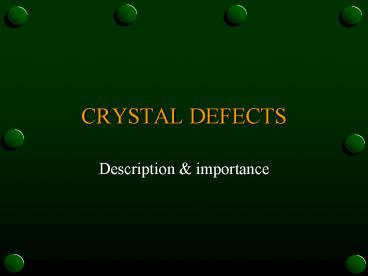CRYSTAL DEFECTS - PowerPoint PPT Presentation
CRYSTAL DEFECTS
Metals are not perfect neither at the macrolevel and nor at the microlevel. Contain a number of different types of crystalline defects (at the atomic level) ... – PowerPoint PPT presentation
Title: CRYSTAL DEFECTS
1
CRYSTAL DEFECTS
- Description importance
2
FUNDAMENTALS
- Metals are not perfect neither at the macrolevel
and nor at the microlevel - Contain a number of different types of
crystalline defects (at the atomic level) - Defects are important in many processes e.g.
diffusion, deformation
3
TYPES OF DEFECTS
A. POINT DEFECTS OR ZERO-DIMENSIONAL DEFECTS
In pure metals
In alloys
1. VACANCY 2. SELF-INTERSTITIAL
1. SUBSTITUTIONAL IMPURITY 2. INTERSTITIAL
IMPURITY
Important in strengthening
Important in diffusion
4
Mechanism of diffusion
VACANCY
5
B. Line defects or one-dimensional defects
Edge dislocation
Screw dislocation
VERY IMPORTANT IN PLASTIC DEFORMATION
6
C. Planar (surface) defects or two-dimensional
defects
1. Stacking Fault
Extrinsic stacking fault
Intrinsic stacking fault
Perfect stacking
A
A
A
A
B
B
A
A
A
A
B
B
B
B
A
A
A
A
C
C
C
C
B
B
B
B
A
A
A
A
C
C
C
C
B
B
A
A
A
A
C
C
C
C
B
B
B
B
A
A
A
A
7
2. Grain Boundaries
8
D. Volume defects or three-dimensional defects
Some scientists classify grains as volume defects
9
QUESTIONS
10
Some basics on alloys
- Two types
Compounds E.g. Fe3C, CuAl2
Solid solutions
Interstitial Solid solution E.g. Steel
(Fe-C) Fe-0.2C or Fe-0.4C
Substitutional Solid solution E.g. Brass
(Cu-Zn) Cu-10Zn or Cu-30Zn
Cu
Zn
Fe
C
11
PHASE DIAGRAMS
PowerShow.com is a leading presentation sharing website. It has millions of presentations already uploaded and available with 1,000s more being uploaded by its users every day. Whatever your area of interest, here you’ll be able to find and view presentations you’ll love and possibly download. And, best of all, it is completely free and easy to use.
You might even have a presentation you’d like to share with others. If so, just upload it to PowerShow.com. We’ll convert it to an HTML5 slideshow that includes all the media types you’ve already added: audio, video, music, pictures, animations and transition effects. Then you can share it with your target audience as well as PowerShow.com’s millions of monthly visitors. And, again, it’s all free.
About the Developers
PowerShow.com is brought to you by CrystalGraphics, the award-winning developer and market-leading publisher of rich-media enhancement products for presentations. Our product offerings include millions of PowerPoint templates, diagrams, animated 3D characters and more.































